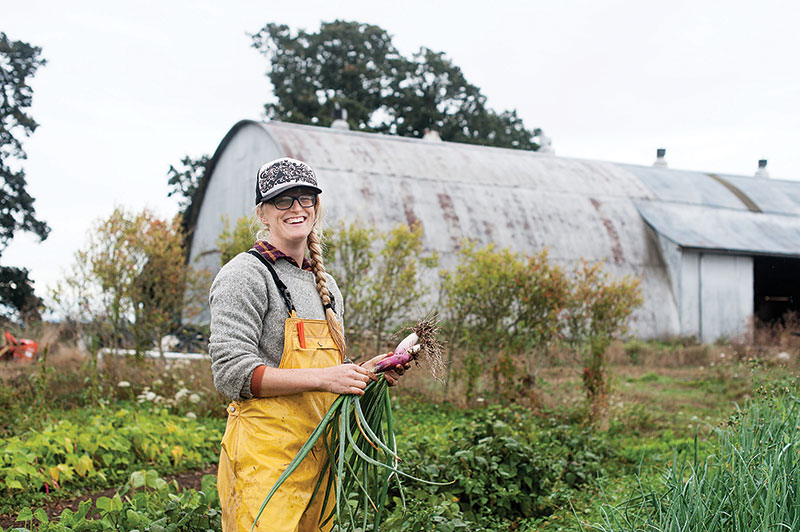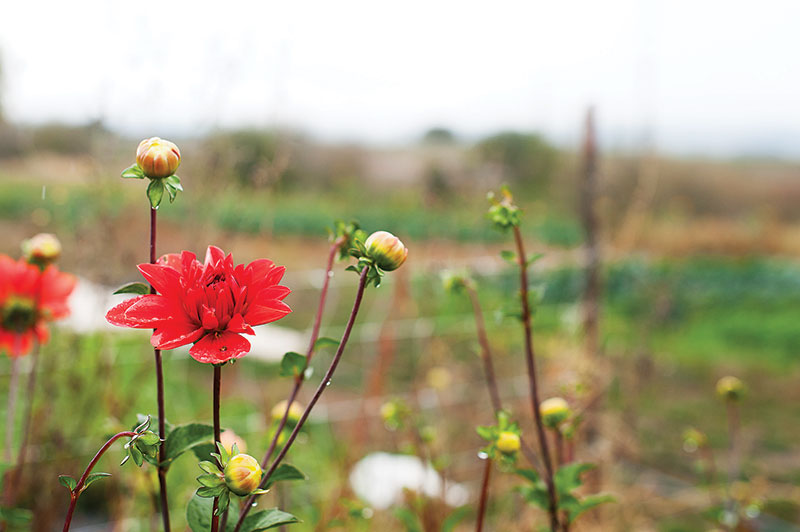
On a cloudy, wet day—exactly the kind of autumn day you’d expect in the Pacific Northwest—Beth Satterwhite navigated her farm’s muddy, trampled paths with ease. Dressed in rainproof Carhartts, her morning was all about harvest, something that her partner, Erik Grimstad, later shared takes about 70 percent of their hands-on farming time. Satterwhite nimbly snapped off vibrant green kale leaves from a long row of plants, before moving on to harvest slightly smaller Swiss chard and a quick-season Italian variety of onion. She worked patiently and methodically, her assurance masking her relative youth and inexperience in the hands-on farming world.

Satterwhite and Grimstad are the sole farmers of Even Pull Farm, a diversified vegetable and flower farm nestled in the heart of Oregon’s Willamette Valley wine country. If you drive out from Portland, the closest major city, you pass through a dense, strip-mall-laden area, where the stoplights mostly obscure the surrounding agricultural beauty. Once you turn off the main highway, however, the chain stores give way to rolling hills, stunning vistas, and acres upon acres of grapevines and crop fields. Some of the crops are industrial in nature—huge swaths of hazelnuts, berries and grass seed—but tucked amongst the thriving wine industry and the more commercialized food enterprises are farms just like Even Pull. These farms grow an impressive number of vegetables on a small number of acres, selling their food to an increasingly interested public, not just in Portland, but in small valley cities, such as McMinnville and Newberg.

Satterwhite is intimately connected with this local community: She grew up nearby and even attended college just a few miles from the current location of their rented farmland. Although Even Pull is only now nearing the end of its second full year in business, Satterwhite’s familiarity with the community has helped her form a variety of partnerships for her farm. “We would not have had customers if I didn’t know people in this town,” she says. “There are plenty of other farms to go to, [so] why would you give me your money?”
In two years, Even Pull has fostered partnerships as diversified as the vegetables and flowers Satterwhite and Grimstad grow. Many farms of Even Pull’s scale—around 2 acres in cultivation—commit to either growing for a CSA or growing for market. Even Pull sells through both these outlets, growing food for well over 40 CSA members and manning a double booth at the local McMinnville farmers market, while also having their produce featured in a plethora of restaurants throughout wine country. Their CSA pick-up is a fitting example of the partnerships common in this community, with members picking up at a nearby wine-tasting room. “Last year was [the tasting room’s] first season, so it was an opportunity for both of us [to attract customers],” Satterwhite says.

Satterwhite initially became attracted to local and sustainable agriculture in college, where she read as much as she could about food systems, volunteered at a community garden, and, along with Grimstead, even challenged herself to maintaining a 100-mile diet. She wrote her senior thesis on the role of CSA farmers in their community, investigating the role of CSAs in the formation of community. Little did she know that a few short years later, she’d be the kind of farmer that her younger self would want to interview. After graduating with a degree in sociology, Satterwhite began solidifying her Oregon farming connections via several local agricultural nonprofits, organizing events, meeting with farmers and championing their causes.
It only took a few years of this work for Satterwhite to realize that she also wanted to be outside, working a single job instead of multiple ones, growing food. “I don’t know if it’s an upgrade or not,” she laughs, “but at least I just have one thing occupying all my brain cells!”

Four years ago, she took an internship at a local farm, where she admits that she just followed the farmers around to learn. The following year, she began to help them with crop planning and CSA management. But when a 2-acre plot of land in the area became available to rent, Satterwhite and Grimstad accelerated their timeline and struck out on their first official solo season in 2015.
Of the two, Satterwhite is the full-time farmer, while Grimstad pulls a double shift, first as a wastewater operator in town and then transitioning to the farm in the evenings and on days off, learning from Satterwhite as he goes. These past two years have solidified his interest in growing food, and he hopes one day to farm full time with his partner. In the meantime, they both separately told me that they’re grateful for his income. “We’re new to running a business and new to farming,” Grimstad says. “It’s nice to have a safety net. It lets you take some risks.”
When they signed the lease for Even Pull’s land, the couple agreed to give farming a solid two-year effort, promising each other that they’d reassess after that time period. “Technically this is our reassess year,” Satterwhite says. Given their growing success and ever-growing community connections and farming skills, combined with an ideal mix of humility and patience, it’s safe to assume that their winter conversation will be different than they might have predicted two years ago.

Despite their share of failures and headaches, not to mention the total exhaustion that comes from farming year round, Satterwhite and Grimstad are ready for what the future may bring, and their local community is lucky to have them. “We saw opportunity,” Satterwhite says. “Now that we’re in further, we still see opportunity for growth. And that’s encouraging.”
Connecting With Chefs
Satterwhite and Grimstad make a point to talk with everyone they see. If they watch someone at the market buying a large quantity of food, the couple will ask who they work for.
“We enjoy working with the chefs a lot,” Satterwhite says. “They value quality and understand what quality is.” They’ve learned that chefs are looking for predictability and easy-to-prepare products, such as salad mixes, leafy greens, beets and tomatoes. And chefs appreciate Even Pull’s ability to hustle.
“I think our willingness to work all winter is a huge reason why we’re having success with chefs,” she says. “They don’t want you to disappear for six months. That’s not helpful for them.”
Marketing Flowers

“Flowers are really interesting,” Satterwhite says. “They’re a challenge to grow and a challenge to sell. It’s a good thing that they’re pretty!”
Unlike her CSA costumers who are thrilled to receive their bouquets, market costumers bemoan the high price tag.
Satterwhite doesn’t have a great response to that comment, explaining that flowers are expensive at grocery stores, as well. “A bouquet the size of mine is $16 at the grocery store; I’m selling them for $15.”
Employee vs. Owner
After two years of working on someone else’s farm, Satterwhite quickly realized that being an employee and a farmer are decidedly not the same thing. As an employee, “you don’t have anything at stake,” she says. “You could love the work, but your relationship with the farm is very different.”
This article originally appeared in the January/February 2017 issue of Hobby Farms.




